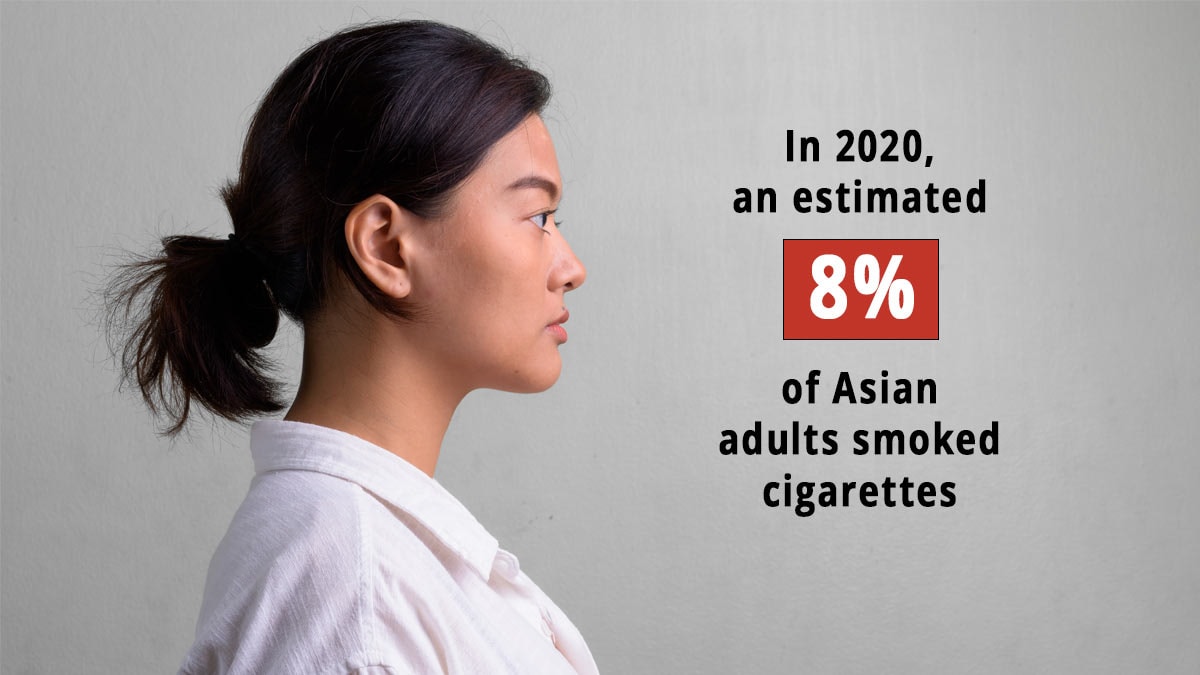At a glance
- Asian, Native Hawaiian, and Pacific Islander (A/NH/PI) communities are made up of people from more than 50 different ethnic and language groups.
- The two leading causes of death among A/NH/PI adults are cancer and heart disease. Cigarette smoking increases the risk of developing these two conditions.

Health burden
Asian, Native Hawaiian, and Pacific Islander (A/NH/PI) communities are diverse—made up of people from more than 50 different ethnic and language groups. In general, A/NH/PI adults smoke cigarettes at a lower prevalence than other racial groups. However, this varies based on the country of heritage.1

Reporting A/NH/PI population groups as one combined group is only one way to estimate the behaviors of A/NH/PI populations as it relates to commercial tobacco use.A When possible, by studying product use separately among each of these populations, we can better identify tobacco product use patterns in each group. For example:
- In 2019, an estimated 18.7% of Native Hawaiian/Pacific Islander adults smoked cigarettes in the past year, compared to 11.5% of Asian adults.2
- In 2024, 17.8% of Native Hawaiian/Pacific Islander middle and high school students reported ever using any tobacco product, compared to 9.3% of Asian middle and high school students.3
- Differences in cigarette smoking are seen among diverse Asian population groups.4 For instance, during 2010–2013, 7.6% of Chinese American adults smoked cigarettes, compared to 20% of Korean adults.5
Commercial tobacco creates challenges in achieving health equity for all people, including for A/NH/PI. A/NH/PI people experience negative health effects related to the use of commercial tobacco products (such as cigarettes, smokeless tobacco, cigars, e-cigarettes).
The two leading causes of death among A/NH/PI adults are cancer and heart disease.6 Cigarette smoking increases the risk of developing these two conditions.7
Lung cancer is the leading cause of cancer deaths among A/NH/PI adults.8 Smoking can cause cancer almost anywhere in the body and, along with secondhand smoke exposure, can cause nearly 90% of all lung cancer deaths.7
Prevalence of cigarette smoking among Asian people in America (2010–2013)9
- 7.6%
- 7.6%
- 10.2%
- 12.6%
- 16.3%
- 20.0%
- "Commercial tobacco" means harmful products that are made and sold by tobacco companies. It does not include "traditional tobacco" used by Indigenous groups for religious or ceremonial purposes.
- Creamer MR, Wang TW, Babb S, et al. Tobacco Product Use and Cessation Indicators Among Adults – United States, 2018. MMWR Morb Mortal Wkly Rep. 2019, 68(45);1013–1019.
- Substance Abuse and Mental Health Services Administration. Table 2.12B-Cigarette use in Past Year among Persons Aged 12 or Older, by Age Group and Demographic Characteristics Percentages, 2018 and 2019. 2018 National Survey on Drug Use and Health Detailed Tables. Substance Abuse and Mental Health Services. Accessed January 4, 2021. https://www.samhsa.gov/data/report/2018-nsduh-detailed-tables
- Jamal A, Park-Lee, E, Birdsey J, et al. Tobacco product use among middle and high school students — National Youth Tobacco Survey, United States. MMWR Morb Mortal Wkly Rep. 2024;73(41):917–924.
- Mattingly DT, Hirschtick JL, and Fleischer NL. Unpacking the Non-Hispanic Other category: differences in patterns of tobacco product use among youth and adults in the United States, 2009–2018. J Immigr Minor Health. 2020;22(6):1368–1372.
- Martell BN, Garrett BE, Caraballo RS. Disparities in Adult Cigarette Smoking — United States, 2002–2005 and 2010–2013. MMWR Morb Mortal Wkly Rep. 2016;65(30):753–758.
- Heron M. Deaths: leading causes for 2018. Natl Vital Stat Rep. 2021;70(4):1–115.
- U.S. Dept of Health and Human Services. The Health Consequences of Smoking: 50 Years of Progress. A Report of the Surgeon General. U.S. Dept of Health and Human Services; 2014. Accessed May 25, 2022. https://www.ncbi.nlm.nih.gov/books/NBK179276/
- Islami F, Ward EM, Sung H, et al. Annual report to the nation on the status of cancer, part 1: National Cancer Statistics. J Natl Cancer Inst. 2021;113(12):1648–1669.
- Centers for Disease Control and Prevention. Disparities in Adult Cigarette Smoking—United States, 2002–2005 and 2010–2013. MMWR Morb Mortal Wkly Rep. 2016;65(30):753–758.
- Odani S, Armour BS, Agaku IT. Racial/Ethnic Disparities in Tobacco Product Use Among Middle and High School Students — United States, 2014–2017. MMWR Morb Mortal Wkly Rep. 2018;67)34):952–957.
